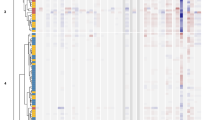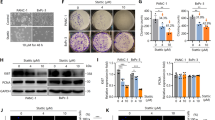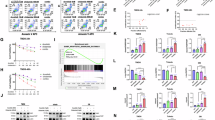Abstract
Previous studies have demonstrated a proapoptotic role for the transcription factor STAT3 in involuting murine mammary epithelium, resulting in delayed involution and lower levels of apoptosis in the STAT3 null gland relative to wild-type controls. As p53 was implicated in the eventual involution of the STAT3 null gland, we examined the effect of STAT3 loss in the mammary gland in a p53 null background. Combined loss of STAT3 and p53 severely perturbed involution, with hyperdelayed loss of epithelium and reappearance of adipocytes. The early apoptotic response was almost completely abrogated, although elevated levels of delayed apoptosis persisted at days 6, 17 and 4 weeks of involution in STAT3-p53 doubly null mammary glands. A 5.7-fold upregulation of the cyclin-dependent kinase inhibitor p21Waf1 at 3 days of involution in STAT3 null glands was abolished in STAT3-p53 doubly null glands – suggesting that the critical factor triggering delayed involution in the STAT3 null gland is a p53-dependent rise in p21Waf1 levels around day 3 of involution. Further, STAT3-p53 doubly null glands showed significantly higher levels of proliferation compared to STAT3 or p53 singly null (or wild-type) glands at days 6, 17 and 4 weeks of involution. Combined loss of STAT3 and p53 therefore results in hyperdelayed involution, demonstrating their synergistic physiological roles in normal involution. This inappropriate retention of p53-deficient cells may represent a novel mechanism of tumour predisposition.
This is a preview of subscription content, access via your institution
Access options
Subscribe to this journal
Receive 50 print issues and online access
$259.00 per year
only $5.18 per issue
Buy this article
- Purchase on SpringerLink
- Instant access to full article PDF
Prices may be subject to local taxes which are calculated during checkout





Similar content being viewed by others
References
Catlett-Falcone R, Landowski TH, Oshiro MM, Turkson J, Levitzki A, Savino R, Ciliberto G, Moscinski L, Fernandez-Luna JL, Nunez G, Dalton WS and Jove R . (1999). Immunity, 10, 105–115.
Chapman RS, Lourenco PC, Tonner E, Flint DJ, Selbert S, Takeda K, Akira S, Clarke AR and Watson CJ . (1999). Genes Dev., 13, 2604–2616.
Clarke AR, Purdie, CA, Harrison DJ, Morris RG, Bird CC, Hooper ML and Wyllie AH . (1993). Nature, 362, 849–852.
Darnell Jr JE . (2002). Nat. Rev. Cancer, 2, 740–749.
Duttaroy A, Qian JF, Smith JS and Wang E . (1997). J. Cell. Biochem., 64, 434–446.
Griffiths SD, Clarke AR, Healy LE, Ross G, Ford AM, Hooper ML, Wyllie AH and Greaves M . (1997). Oncogene, 14, 523–531.
Jerry DJ, Kuperwasser C, Downing SR, Pinkas J, He C, Dickinson E, Marconi S and Naber SP . (1998). Oncogene, 17, 2305–2312.
Li M, Hu J, Heermeier K, Hennighausen L and Furth PA . (1996). Cell Growth Differ., 7, 13–20.
Sansom OJ and Clarke AR . (2000). Mutat. Res., 452, 149–162.
Selbert S, Bentley, DJ, Melton DW, Rannie D, Lourenco P, Watson CJ and Clarke AR . (1998). Transgenic Res., 7, 387–396.
Takeda K, Kaisho T, Yoshida N, Takeda J, Kishimoto T and Akira S . (1998). J. Immunol., 161, 4652–4660.
Takeda K, Noguchi K, Shi W, Tanaka T, Matsumoto M, Yoshida N, Kishimoto T and Akira S . (1997). Proc. Natl. Acad. Sci. USA, 94, 3801–3804.
Toft NJ, Winton DJ, Kelly J, Howard LA, Dekker M, Riele HT, Arends MJ, Wyllie AH, Margison GP and Clarke AR . (1999). Proc. Natl. Acad. Sci. USA, 96, 3911–3915.
Tonner E, Barber MC, Allan GJ, Beattie J, Webster J, Whitelaw CBA and Flint DJ . (2002). Development, 129, 4547–4557.
Vousden KH and Lu X . (2002). Nat. Rev. Cancer, 2, 594–604.
Yi Y, Shepard A, Kittrell F, Mulac-Jericevic B, Medina D and Said TK . (2004). Mol. Biol. Cell, 15, 2302–2311.
Yu H and Jove R . (2004). Nat. Rev. Cancer, 4, 97–105.
Zhang Y, Xiong Y and Yarbrough WG . (1998). Cell, 92, 725–734.
Acknowledgements
This work was supported by the AICR and the Wales Gene Park. We are grateful to Andrea Daniels for technical assistance and to Professor S Akira for providing mice carrying the STAT3 floxed and null alleles.
Author information
Authors and Affiliations
Corresponding author
Rights and permissions
About this article
Cite this article
Matthews, J., Clarke, A. p53 mediates a default programme of mammary gland involution in the absence of STAT3. Oncogene 24, 3083–3090 (2005). https://doi.org/10.1038/sj.onc.1208512
Received:
Revised:
Accepted:
Published:
Issue date:
DOI: https://doi.org/10.1038/sj.onc.1208512
Keywords
This article is cited by
-
Fur removal promotes an earlier expression of involution-related genes in mammary gland of lactating mice
Journal of Comparative Physiology B (2023)
-
The BH3-only protein BIM contributes to late-stage involution in the mouse mammary gland
Cell Death & Differentiation (2016)
-
Dispersal of an ancient retroposon in the TP53 promoter of Bovidae: phylogeny, novel mechanisms, and potential implications for cow milk persistency
BMC Genomics (2015)
-
p63 is a prosurvival factor in the adult mammary gland during post-lactational involution, affecting PI-MECs and ErbB2 tumorigenesis
Cell Death & Differentiation (2014)



